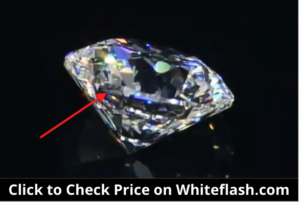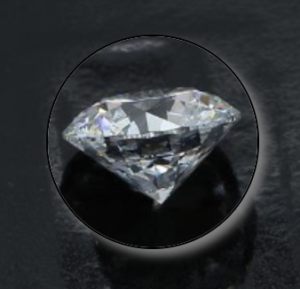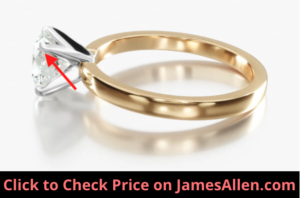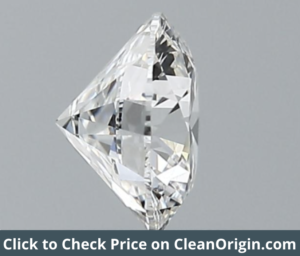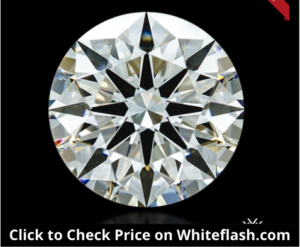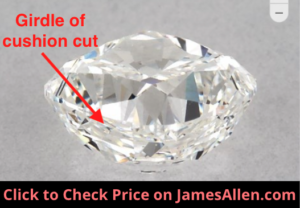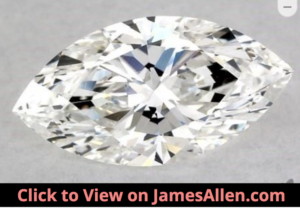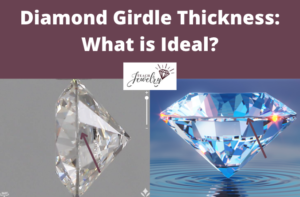
Each part of a diamond impacts its appearance and light performance, so it’s important to know the anatomy of a diamond.
One example is the diamond’s girdle.
My bottom line recommendation is the ideal girdle for round cut diamonds is between thin to slightly thick. For fancy shapes, it’s the same range, but very thick is also acceptable.
Let’s explore what a diamond girdle is, the three types, how its thickness is graded and its impact, and what you should know about girdles for fancy shaped diamonds.
What is a Diamond Girdle?
Girdles are the part of the diamond that separates the top (the crown) from the bottom (the pavilion). When viewing the diamond from the top, the girdle creates the outline. When viewed from the side, it divides the round top from the pointed bottom.
I’ve highlighted the girdle of the diamond below.
Notice how thin it is relative to the two halves it divides.
All diamonds have a girdle, but they vary in size and how they’re polished. It’s where diamonds are set and held in place, so it’s durability and ability to withstand impact is a critical component.
If you buy a diamond that’s been graded by a certifying institution, it’s like the laser inscription is located on the girdle.
Types of Diamond Girdles
Faceted
Faceted girdles maximize a diamond’s glimmer, especially on brilliant round cuts. The style features a number of small, polished sides that wrap around the diamond.
Check out the faceted girdle on this diamond.
Notice the small vertical lines that run up and down.
The manufacturer cuts the facets around the perimeter of the diamond and removes any feathers formed during the process of bruting. The advantage is it allows the facets of the girdle to go unnoticed because they properly reflect white light and blend in with the diamond.
Though it does provide this stronger light performance, you generally won’t see a price increase as a result of a faceted girdle versus polished or unpolished.
Polished
A polished girdle is a continuous facet that lines the circumference of the diamond.
It’s most commonly seen in step cut diamonds such as emerald, Asscher, or baguette because of their elongated facets, but it’s also found in brilliant round and princess cuts.
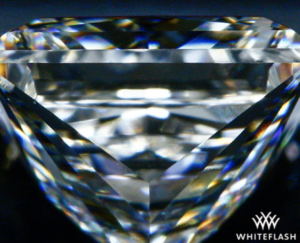
A polished girdle allows you to see inside the body of the diamond because the facet is clear. If you run your finger along the girdle, you won’t feel any bumps, but instead it’ll be a smooth line.
Even though faceted girdles boast the strongest light performance, the effects of the polished style compared to faceted likely won’t result in any noticeable differences to the naked eye.
Unpolished (Bruted)
It’s unusual to find a diamond today with an unpolished girdle, also referred to as bruted or frosted finishes. By abrading one diamond against another, it creates a rough edge around the diamond. If you run your finger along it, you’ll notice it’s anything but smooth.
Here’s a close-up image of an unpolished girdle.
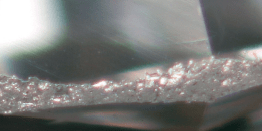
It appears uneven, and the width is inconsistent as it circles the gem. It mimics the surface you’d expect in the original diamond.
But all faceted diamonds are actually first bruted. Cracks and feathers that form during this process are removed during the faceting.
One advantage of an unpolished girdle is it minimizes the carat weight lost during faceting. For faceted and polished girdles, some of the diamond is cut away to create the smooth or faceted finish.
The disadvantage is it results in the worst light performance of the three styles. The rough edges don’t properly reflect light, and it collect oils and dirt over time. This causes the stone to darken and requires more frequent cleaning.
Diamond Girdle Thickness Grades
A girdle’s thickness is indicated by a percentage. You take the girdle’s thickness, in millimeters, divided by its average diameter, and multiply it by 100.

It’s measured the same way whether the girdle is faceted, polished, or bruted, so the exact type does not influence its thickness.
The girdle’s grade is assigned by examining it at its thinnest and thickest points.
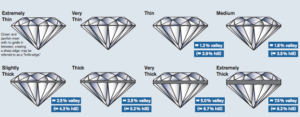
Girdles are classified with the following grades:
Extremely Thin (ETN): Extremely thin girdles are almost invisible, creating what looks like a knife edge in the middle of your diamond. It negatively impacts the cut grade, so it’s unlikely you’ll find one with an extremely thin girdle and excellent cut.
Very Thin (VTN): Diamonds with a very thin girdle will often not be given an excellent cut grade, but on the higher end can be graded very good. It’s not as vulnerable to chipping as an extremely thin grade, but you should still choose a strong setting to withstand impact.
Thin (T or TN): Thin, along with medium and slightly thick, is considered an ideal girdle thickness for round cuts because it doesn’t hide the weight of a diamond, and it enhances durability.
Medium (M or MED): Diamonds with a medium girdle thickness are also ideal because it balances the concerns of optics and durability. If you find an excellent or ideal cut, it may have a medium girdle.
Slightly Thick (STK): Diamonds with slightly thick girdles can still earn an excellent cut grade, but it’s pushing the boundaries on some of the negative effects of a thick girdle.
Thick (TK or TH): You shouldn’t dismiss a diamond that has all the other qualities you’re looking for but a thick girdle. It can still receive an excellent cut grade and give you peace of mind about its durability. Its impact on light performance likely won’t be noticeable to the naked eye compared to other widths.
Very Thick (VTK or VTH): While it may keep the diamond from cracking or chipping, a very thick girdle can hide the diamond’s carat weight so it appears smaller.If you placed two diamonds of the same carat weight next to each other, and one had a thin girdle and the other was very thick, the former may look larger. Additionally, it hinders light performance by allowing the light to escape through the girdle or pavilion.
Extremely Thick (ET or EXTK): Just like extremely thin girdles cause problems with the diamond’s cut grade, the same is true with extremely thick girdles. It can result in a “fisheye” effect, where you see a reflection of the girdle inside the diamond, and hinders its glimmer.
The differences between any one grade and one level thicker or thinner are generally minimal, so you shouldn’t expect distinct appearances or light performances when making that selection.
But when you compare diamonds with a girdle thickness several grades apart, that’s where it may impact its overall quality.
Diamond Girdles in Grading Reports
If your diamond has been graded by a credible certifying institution, its girdle thickness appears on the report.
The girdle is examined by a gemologist at 10X magnification, looking at its thickness all the way around as well as the “hills” and “valleys” where the girdle falls and rises.
I’ve posted an image of a GIA grading report below with the proportions diagram.
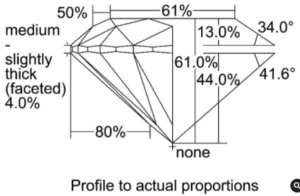
The girdle thickness is noted on the left side, as well as its type and percentage.
The gemologist specifies its grade based on the thinnest and thickest parts. It explains why you might see the girdle with two classifications, such as “medium to slightly thick.”
In the case of a consistent girdle, it will be assigned one grade such as “extremely thick.”
A diamond’s girdle impacts the grades its given in other areas of the report, such as its symmetry.
For example, if the girdle is wavy, it likely won’t be designated as having perfect symmetry. If the variations between the thinnest and thickest points in the girdle are too significant, the diamond won’t be proportionate.
How Does Girdle Thickness Impact a Diamond?
Durability
Diamonds are supposed to last forever, so consider its durability in your purchasing decision. There are several aspects that impact its longevity, and girdle is one of them.
An extremely thin or thin girdle leaves your diamond more vulnerable to chips or breaks. Diamonds are held in place with the setting on the girdle, so a thin girdle can’t embrace impact in the same way a thicker one can.
Additionally, a prong setting can wear down a thin girdle, causing feathers to form. This engagement ring uses prongs to grasp over the diamond girdle.
Feathers are a type of diamond inclusion that appear as fissures or jagged lines. It isn’t a high risk, but it can easily be avoided by choosing a girdle that earns at least a medium grade or placing it in a bezel setting.
For example, this round-cut diamond has a medium to slightly thick girdle.
This eliminates durability issues related to its girdle thickness because it falls within that acceptable range.
Carat Weight
Carat weight is one of the most prominent features of a diamond. Buyers want to find the largest diamond that fits within their budget.
Choosing a diamond with an extremely thick girdle isn’t your best option if you’re primarily concerned with maximizing its appearance relative to weight. This is because the extremely thick girdle hides much of the diamond’s weight.
For example, if you took one diamond weighing 1.5 carats with an extremely thick girdle, and another weight 1.3 carats with a thin girdle, they could appear the same size when viewed from the top down.
That extra 0.2 carats likely costs several hundred dollars, but its girdle wastes that weight.
Brilliance
Strong light return is what makes a diamond brilliant. Ideally, light enters the diamond and is then directed back out through its table. As it exits the diamond, it’s dispersed, which results in the glimmer expected in a quality diamond.
This diamond earned an ideal cut grade, partly due to its thin to medium girdle.
With excellent polish and symmetry, it’ll properly collect and reflect white light.
A very thick or extremely thick girdle can negatively impact light performance if it’s not cut with ideal proportions. The girdle would be too deep to properly reflect the light back out through the table at the perfect angle.
Instead, it bounces around the stone and can cause the fisheye effect.
A diamond with an extremely thin girdle can experience a similar problem but for different reasons. Extremely thin girdles often receive lower cut grades, and cut is the factor that most influences light performance.
Cut
Cut impacts the way light enters and is reflected from a diamond.
It’s considered the most important of the four Cs in the diamond’s overall performance. While you should look for value in choosing a color and clarity grade, paying the premium for an excellent or ideal cut is worth it.
The connection between a diamond’s girdle and its cut quality involves symmetry. The GIA grades symmetry for round cut diamonds according to the exactness of its shape and the symmetrical arrangement of its facets, and this includes the girdle.
Additionally, the average girdle thickness and the minimum and maximum widths are included in the grading system. They examine the 16 valley positions and how thick they are compared to the diameter of the diamond.
A girdle thickness on either extreme doesn’t mean it automatically receives a lower cut grade, but diamonds graded excellent or ideal generally have thin to slightly thick girdles.
Girdles for Fancy Shape Diamonds
Much of the advice about the right girdle on a diamond applies to round cut diamonds. It’s less important for fancy shapes such as princess, emerald, or Asscher cuts.
The girdle thickness has minimal impact on light performance and hiding carat weight for fancy shapes. But if you are searching for the right girdle in a fancy shape diamond, opt for thin, thick, or a grade in between.
Some fancy shapes are known for having a particular girdle thickness. For example, cushion cuts often have thicker girdles, and the same is true for step cuts.
One concern for those considering a fancy shape is how they’re sometimes less durable in the corners or on the edges.
For example, marquise shape diamonds have pointed edges.
In this case, it’s recommended to err on the side of a thick girdle for added protection.
How to Decide on a Diamond’s Girdle Thickness
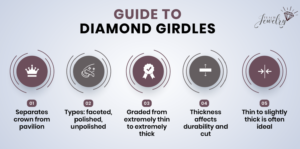
There are many aspects of a diamond to consider when selecting the right one to buy, and girdle is usually low on the list in terms of its importance.
It’s incorporated into the diamond’s symmetry and cut grades. While the ideal choice is thin to slightly thick, you shouldn’t let the specifics weigh too heavily on your decision.
This is especially true of fancy shape diamonds, where the girdle has even less of an impact compared to traditional round cuts.
Ensure you’re choosing a diamond that’s graded by a credible organization, and note the girdle thickness in case you need to select a particular setting to pair with it.
From there, focus on the other qualities of a diamond such as the four Cs, it’s eye-cleanliness, and price, and you’ll be confident in your choice of diamond.

Jacob Clarke
Jacob Clarke is the founder of TeachJewelry.com.
He earned an Applied Jewelry Professional Diploma from the Gemological Institute of America (GIA) and now brings you essential information about diamonds, settings, and more.
Jacob has consulted with leading jewelry brands, and his work has been cited in Clean Origin, Diamond Nexus and industry publications.
He's also a member of the International Gem Society.
He enjoys discussing jewelry with readers, so contact him with any questions at jacob.clarke@teachjewelry.com.

